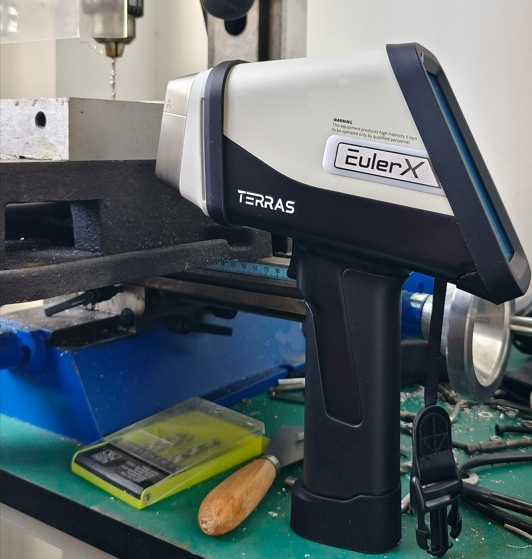
Alloy
A high-tech enterprise focusing on the development and application of X-ray technology products, committed to becoming a leading supplier of X-ray industrial testing solutions.
The Science Behind XRF Alloy Analyzers: How Do They Determine Metal Composition?
In the realm of metallurgy and materials science, the ability to accurately determine the composition of metals is paramount. One of the most effective tools for this purpose is the XRF (X-ray fluorescence) alloy analyzer. These sophisticated devices harness the principles of physics and chemistry to provide precise, non-destructive analysis of metallic samples. But how exactly do XRF alloy analyzers work? Let's delve into the science behind these powerful instruments and explore how they determine metal composition.

Understanding X-Ray Fluorescence
X-ray fluorescence (XRF) is a phenomenon in which a material emits secondary X-rays when it is excited by a primary X-ray source. This process can be broken down into several key steps:
Excitation: The XRF analyzer directs a beam of primary X-rays onto the metal sample. These high-energy X-rays are generated typically by an X-ray tube within the device.
Ejection of Electrons: When the primary X-rays collide with the atoms in the sample, they transfer energy to the electrons in the inner shells of these atoms. This energy is often sufficient to eject these electrons from their orbits, creating vacancies.
Fluorescence Emission: To fill these vacancies, electrons from higher energy levels within the atom drop down to the lower energy levels. As they do so, they emit X-rays with specific energies. These emitted X-rays are characteristic of the elements present in the sample, forming what is known as a fluorescence spectrum.
Analyzing the Spectrum
The fluorescence spectrum emitted by the sample contains peaks at energies corresponding to the various elements in the alloy. Each element has a unique set of energy levels, resulting in a unique spectral fingerprint. Here's how the analyzer interprets this information:
Detection: The emitted X-rays are detected by a sensitive detector within the XRF analyzer, typically a silicon drift detector (SDD) or a proportional counter.
Energy Measurement: The detector measures the energy of each incoming X-ray photon. This is crucial because the energy corresponds directly to the type of element that emitted the X-ray.
Spectrum Creation: The analyzer compiles these energy measurements into a spectrum, a graphical representation showing the intensity of detected X-rays against their energies.
Element Identification: By comparing the measured energies to known values, the analyzer identifies the elements present in the sample. Each peak in the spectrum is matched to an element.
Quantitative Analysis: The height and area under each peak are proportional to the concentration of the corresponding element in the sample. Advanced software algorithms then quantify the composition by calculating the relative intensities of these peaks.

Calibration and Standards
For accurate results, XRF analyzers must be properly calibrated using standards of known composition. Calibration ensures that the intensity of the detected X-rays can be accurately correlated to the concentrations of elements in the sample. Regular calibration is essential for maintaining the precision and accuracy of the analysis.
Applications of XRF Alloy Analyzers
XRF alloy analyzers are used across various industries due to their speed, accuracy, and non-destructive nature. Some of the key applications include:
Quality Control in Manufacturing: Ensuring the correct alloy composition in products such as automotive parts, aerospace components, and consumer electronics.
Scrap Metal Recycling: Identifying and sorting different types of metals quickly and efficiently.
Environmental Monitoring: Detecting and analyzing trace metals in soil and water samples.
Mining and Geology: Analyzing the composition of ores and minerals on-site.
Advantages of XRF Analysis
Non-Destructive Testing: XRF analysis does not alter or damage the sample, making it ideal for testing valuable or delicate items.
Speed and Efficiency: Results are obtained within minutes, allowing for rapid decision-making.
Versatility: Capable of analyzing a wide range of elements from heavy metals to lighter elements in various matrices.
Portability: Modern handheld XRF analyzers enable field testing, bringing the lab to the sample.
Conclusion
The Terra EulerX 900 series analyzers integrate advanced algorithms and comprehensive alloy grade databases to automatically match alloy models based on elemental compositions. This functionality proves invaluable in industries reliant on precise alloy specifications, facilitating seamless integration into quality control measures, raw material procurement, and manufacturing protocols.
XRF alloy analyzers are a testament to the power of applied science in solving practical problems. By leveraging the principles of X-ray fluorescence, these devices provide a reliable and efficient means of determining metal composition in a wide array of applications. Whether in a factory, a recycling center, or out in the field, XRF analyzers are indispensable tools for ensuring the quality and consistency of metal products. As technology advances, we can expect even greater precision and versatility from these remarkable instruments.
Join Us
Subscribe to our email list for updates & promotions.



